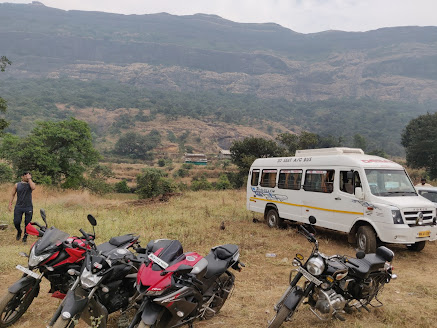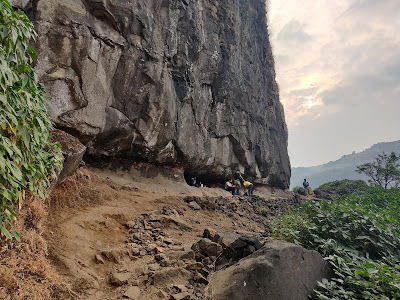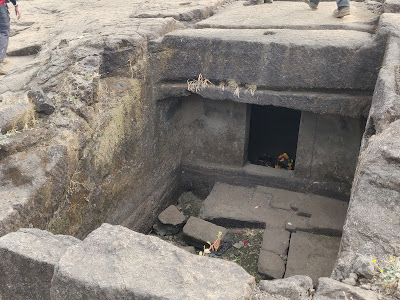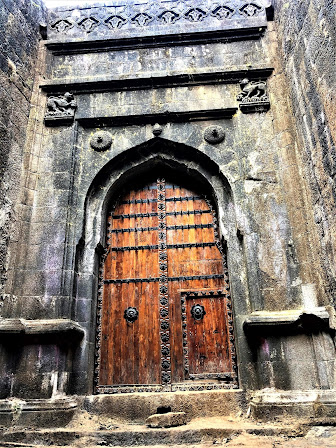Memorable Winter Trek to HARISHCHANDRAGAD & KONKANKADA Camping
MEMORABLE TREK TO HARISHCHANDRAGAD
AND KONKANKADA CAMPING 12-13 December
2020.
Harishchandragad Fort is situated in the Junnar region near Malshej Ghat in Ahmednagar district. It is almost 200 kilometers away from both Mumbai and Pune cities of Maharashtra state, India. It takes 5 hours’ road journey from Mumbai. This area comes under the Kalsubai-Harishchandragad Wildlife sanctuary. Therefore, the area is rich in flora and fauna. The range offers various action pack adventure activities to trekkers and adventure lovers. The fort is extremely popular amongst trekkers and nature lovers. Though the trekkers hike the Harishchandragad and Konkankada in all the seasons but Monsoon and Winter seasons are the most preferred season. In monsoon, the whole region becomes lush green and lots of sparkling seasonal waterfalls can be seen in this area. The Konkakada offers an amazing view of the surrounding regions. Winter is a camping season. Trekkers and nature lovers trek as well as do night camping at Harischandragad and Konkankada area to get the lifetime experience of being in nature and cold winter.
TREK
DETAILS:
- Height: 4671ft
- Region: Junnar
- Difficulty level:
- Pachnai route: Easy
- Khireshwar route: Easy
- Nali Chi Vat route: Difficult
- Popular Activities: Rappelling,Rock Climbing,Valley crossing,Camping
- Best time: Monsoon & Winter( September is an ideal season)
- Base Village of Harishchandragad
- Pachnai & Khireshwar
- Belpada for Nali Chi Vat route
- Location: Malshej Ghat, Ahmednagar, Maharashtra
How to Reach Harishchnadragad
Harishchandragad can be approached through 4-5
known routes but there are three most preferred or popular routes based on the
trekker’s itinerary.
Way from
Khireshwar
Khireshwar is the base camp for this route which is also known as Tolar khind, which
demands good endurance but not technical. This route is one
of the most preferred routes by trekkers even though it is a much longer route. The
ST bus is available from Kalyan ST depot to Khubi phata, which is 6 km from Khireshwar the base
village for the trek. ST going towards Alephata (via Malshej Ghat the bus stops a little away from Khubi Phata at a distance of 5 km away from the base
village. You have to walk till the Khireshwar. If you are taking a private
vehicle then you can drive directly to the base village. The route from
Khireshwar to Harishchandragad offers pleasant nature trail except for the Tolar
Khind patch which is a rocky patch and it is very slippery during the monsoon
and very risky to travel without the proper guide and group to support you. I
would suggest the hikers take the Pachnai route in monsoon. Especially if
you are a beginner or doing a solo trek.
This route is considered as the easiest route
amongst all other routes, Pachnai village, you can reach by buses or private
vehicles. Buses coming from Rajur, Akole, or from Kotul. From Kotul the distance
is 25 km with buses going every hour towards Pachnai & Kothale. From
Kothale, Pachnai is 5 km away, you can reach there by local transport. But
issue with the frequency. One good idea is if you are a group of 5 or 7
hikers, hire a jeep from Kasara for both the ways. They will take you
directly to the Harishchandragad on time.
If you are coming by private vehicle. It may take 5 hours of the long
journey and the last one-hour drive will be a bumpy ride because of the rough road.
Make sure that you have an extra tyre attached to your car or jeep.
From Pachnai to Harishchandragad is around 2 hours
if you take a few pauses in between.
The way from Nalichi Vaat – Walhiware village is a base village. Very remote village 10 km inside from main Malshej ghat road. Nalichi Vaat (it means a passage through a gorge) is a path that lies to the extreme right of the mountain. It is the most difficult path to the top. Popular among climbers and experienced trekkers, Nalichi Vaat involves a near 80-degree climb, involving steep rock patches. The trail begins on a stream bed filled with large man-sized rocks and eventually leads to the foot of the gorge(Nali). This route is only for experienced trekkers and climbers. It requires a good fitness level and climbing experience.
My
Journey to Harishchandra and Konkankada camping
Winter is a good season for night treks and camping
at Sahyadri ranges. I am a part of many trek organizer WhatsApp groups. So they
keep posting their upcoming events. That’s how I got to know that Treks and Trail
are coming up with the Harishchandragad trek and Kokankada night camping. I like
the plan and immediately registered it and reserved a seat for myself. Though I
have already hiked the Harishchandragad and Kokankada in Monsoon. I like the
idea of camping at Kokankada. The organizer had chosen the Pachnai route as
they got mixed groups. Few of them are beginners.
So our plan was to hike up to Harishchandragad and
camp at Kokankada.
Neil and Param was our trek leader and who is going
to lead this trek. Both were qualified and experienced trekkers.
I boarded my bus from Teenhath Naka, Thane and we started our journey on time.
There were 14 hikers and a good mix of gender as well
as age-wise. Most of them were experienced hikers except for two young boys.
We all proceed towards our destination and after two
hours, we took a break for our breakfast. The routes were a bit confusing and
come across many villages on the way. We took Igatpuri, Kalsubai, Bhandara and
Rajur route.
We have also come across Kulangwadi on the way which is a base village for AMK trek and many other villages. There was no network at some point and the last leg of the journey was quite bumpy ride.
We reached Pachnai around 2 pm as per the scheduled time and we
had our quick lunch here. To our surprise, the village was hustling and bustling
with trekkers. There were already many groups who have arrived before us. We had
to stand in a queue to get our food. We proceed on our journey after the quick
lunch and the briefing session.
The nature of the trail is almost all ascending. However,
this route is considered the easiest route as compared to other routes and
villagers also take this route to visit Harishchandragad Temple for darshan.
Harishchandragad Entry Gate
As we walked towards the main entry gate. The trail slowly took us towards the ascending. After ascending for half an hour, we reached a flat land where we took a few minutes break and waited for others to join us. From there climb becomes steeper but there are iron railings for support which makes our climb much easier.In monsoon, there is the waterfall from the top which gives you a good shower. From there the trail was almost straight up to the bridge. In monsoon,
we can see the powerful stream running through it and the area becomes a bit slippery. After crossing the bridge there is a Limbu paani stall by villagers and it is a good spot to hydrate ourselves.
From there we had to ascend again for the last leg of our journey.
We reached a plateau after a 20 minutes of ascending and we can get the first view of surrounding hills and Harishchandragad. We reached the Harishchandragad and wait for others to join. Lots of new shacks have come up in the area. The place has become more commercialized now.
I could see the area in different shades as I visited this area in Monsoon two years back.
We moved straight to Konkankada which is twenty minutes’ walk from Harishchandragad. It was getting dark now. We quickly proceeded further towards the Kokankada. The route is pretty simple. First short descending and then straight route.
Finally, we reached Konkankada. It was dusk time and the place was crowded already. Many people have already arrived here for camping. We just had a quick view of Konkankada before it gets too dark.
Our trek leader has to arrange a tent. So they went off to meet Bhaskar (The tent provider) We had a cup of tea and some dry snacks near one of the local stalls at Konkankada. It was getting colder and feels good. Our trek leader took time to come back to us, meanwhile, we decided to go towards the hillside and collect some wood for the bonfire to keep ourselves warm from the cold. Camping without a bonfire is incomplete. Unfortunately, people have already collected most of the woods and there were hardly any left for us. Somehow we managed to collect a few dry kinds of wood and some grass. We also removed some branches from the trees. I noticed that many plastic cups and
thalis were thronging the forest area which is worrisome and irresponsible behavior. We are polluting such a pristine place. As per our plan, we set a nice bonfire and had good fun. Listen to some melodies songs played from a Bluetooth speaker. We had a good interaction with each other. We just got to know that there some confusion booking a tent so our leader was struggling to get a tent for us. Finally, they managed to get a tent from other localities.
Camping at Kokankada
We quickly pitched our tent. The good places were all occupied. So we just had to settle near the main road. We shared one tent for three people and allotted one tent for each couple. Next was dinner. We had to wait for our turn for dinner. There was only one stall who is providing food for all the trekkers. I was pretty hungry and the food was simple thali but it was good and tasty. After dinner, we walk around and join some other bonfire group and enjoyed the chill wind. The temperature drops down in the night and we went inside our tent to end our day.
We roamed around the Kokankada for some time and
finally, our guide called us to start our return journey. We went back to
Harishchandragad and had our breakfast.
After breakfast, we went ahead to explore
Harishchandragad.
Things to see at Harishchandragad:
Harishchandragad is one of the historic places as
there were lots of evidence around. There are many caves and ancient remnants of 6th
century can be seen around. Harishchandragad has been referred to in many ancient scriptures
like Matsyapurana, Agnipurana, etc. The
legend says that the great sage Changdev used to meditate here
in the 14th century. Later the fort was under the control of Moguls. The
Marathas captured it in 1747.
Saptatirtha
Pushkarni
Towards the east of the temple is a beautiful built lake
called “Saptatirtha”. On its bank are many tiny temple-like constructions in
which there are idols of Lord Vishnu in every temple. It seems that these idols
have been shifted in the caves near the temple of Harishchandreshwar. At
present, the lake is not a good shape as it is spoiled by irresponsible
trekkers and visitors. In Monsoon, when the lake becomes full, trekkers swim in the lake. Now I can see that the water in the lake has become contaminated
and become fully green.
Caves on
Harishchandragad
There are many caves spread out all over the fort.
Many of these are situated at the foothills of Taramati peak and are the place
of accommodation. A few are near the temple, whereas some are near the citadel
and some far away in the forests. A 30 feet (9.1 m) deep natural cave is on the
north-western side of the fort, to the right of Kokankada. Many other caves are
still said to remain undiscovered. These caves are used by the trekkers in
monsoon season.
Temple of
Harishchandreshwar
This temple is the main attraction and the visible
evidence of a marvelous fine art of carving sculptures out of stones that prevailed
in ancient India. It is said that the whole temple has been carved out of one
huge rock. The top of the temple resembles construction with the North-Indian
temples. A similar temple is situated in Buddha-Gaya. The temple has entrances
from all four sides. On the left side of the entrance is a Devnagari
inscription, which is about saint Changdev.
There are
few caves and water tanks around the temple. It is believed that the origin of the river
Mangal Ganga is from one of the tanks. Here we can see many tombs, in which a
typical construction is seen. These are built by well-finished arranging stones
one on top of the other. There are three main caves near the temple. The
cisterns near the temple provide drinking water. The local priest offers daily
prayers to this temple.
Kedareshwar Cave
Towards the right side of Harishchandreshwar temple, there is a
huge cave of Kedareshwar and there is a big Shiva Linga, which is
completely surrounded by water. Its height from the base is five feet, and the
water is waist-deep. The water is very cold and remains all four seasons. I
have noticed that there are sculptures carved out in the cave. In the monsoon, it is difficult to reach this cave, as a huge stream flows across the way. There
were four pillars built around the Shiva Linga to support the cave. But only
one pillar is left.
The interesting thing about this cave is that water
seeps into these caves from the four walls on an everyday basis. It is said that
the water continues to seep in during all the seasons of the year. During the rainy season, the water level in the cave becomes almost waist-high.
Taramati peak
It is also known as Taramanchi. This is the topmost point on the Harischandragad fort (1429 meters). It is considered the second-highest peak in Maharashtra. The peak offers a glimpse of the whole range of Naneghat and the forts near Murbad. From Taramati point, we can have a glimpse of forts till Siddhagad near Bhimashankar in the south and Napta twin peaks, Ghodishep (865 meters), Ajoba (1375 meters), Kulang fort (1471 meters) in the north near the Kasara region. These all depend on the clarity of the weather. Trekkers climb this peak early morning to witness the sunrise.
We explored the Harishchandragad for almost one hour and took a group picture and then we started our return journey. Within one hour we reached the
base village and the plan is to have lunch at Pachanai but many group members
refused to have simple lunch at the village. They want to have lunch at some
good Dhaba on the way. Our trek leader has fulfilled our wish. We
reached Mumbai around 9.15 PM.
Your journey becomes more memorable when you have a good partner.
Fortunately trek mates were all very good and warm people. I really enjoyed
interacting with all of them. I do hope that I will meet some of them in some
other trekking event.
TIPS
- Wearing comfortable Hiking SHOE is a must.
- Cap, UV sunglasses, sunscreen lotion are a must to protect your skin and eyes from the direct sun if you are traveling post-monsoon or in winter.
- A good rain jacket is a must to protect yourself and your backpack if you are visiting Harishchandragad in the monsoon.
- Carry at least 2-liter water bottles and some ready to eat snacks
- Leave the trail, not the trash. Bring your trash back to the city and dispose of it in a dustbin
- Be sensitive towards villagers when you are interacting with them. Make sure that you are not going to hurt their sentiments.
- Respect the culture and beliefs of the local people.Thats their identity.
- Be mindful when you are visiting the Harishchanddreshwar temple and Kedareshwar cave. These are very sacred places and It is our History.
- Do not attempt the Nali Chi Vat route if you are a casual hiker or beginner unless you are fit and guided by the trekking leader or experienced hikers.
- The best time to visit Harishchandragad is Monsoon and Winter. September month is the ideal time to visit.
- If you are a group, I would recommend book a direct JEEP from Kasara to Pachnai. This will save your time and energy.
- Contact Bhaskar Mob:8308081939 & Prakash Mob: 7350826486 for camping at Konkankada and Harishchandragad. They both will arrange the tent as well as the food.



















































No comments: